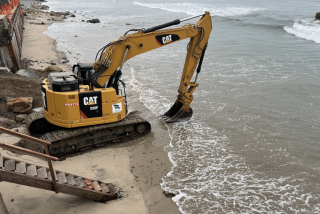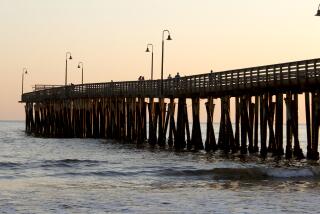Commentary : Legacy of State’s Coastal Act Can Be Seen by What’s Not There Now
As spades begin to turn over dirt on the majestic coastal lands between Corona del Mar and Laguna Beach, it seems appropriate to think about what might have been had there been no Coastal Act.
It is no accident that those who use Coast Highway have a glorious view of the Pacific Ocean for a 3-mile stretch along the Irvine Coast. It is no accident that the public now has access to the beaches that hug the bluffs that line the water’s edge. It is no accident that when development takes place on the inland side of the Irvine downcoast property, wildlife habitats will be protected, the watershed will remain, the effects of traffic and air pollution will be minimized, and both the public and the landowner will benefit.
The present Irvine development plan is no accident because the Coastal Act forced discussions among the Irvine Co., government agencies and environmentalists who together shaped the company’s plans. Had there been no Coastal Act, chances are there would now be fewer views, limited public access, fewer wildlife habitats and watersheds preserved, and more intense development.
This is not to suggest that the Irvine Co. has no social conscience nor concern for environmental quality. However, the goal of a landowner is to develop land to its highest and best use. This does not always generate views available to the public, access and environmental quality. Therefore, it is the role of government to see that a given development does not adversely affect the quality of the environment.
Monitoring development along the coast is the task that was given to the Coastal Commission by the 1972 Coastal Act, and monitor it does! Yet for a variety of reasons, most residents have little awareness of the connection between the California Coastal Act and the coastal landscape in Orange County.
The Irvine Coast development plan is but one example of the monitoring process. Other examples abound. Before the Coastal Act was passed, the Avco property in Laguna Niguel (part of which is home to the Ritz-Carlton hotel) was planned for much more intense private development. The original Avco plans called for a commercial strip along Coast Highway, a private golf course that would not extend to the sea, and building that would make the sticks and stucco in the area there today seem insignificant.
Coastal commissioners and their staff spent years working with Avco to change the company’s blueprints. And although there are still pockets of opposition to what is being built, the Laguna Niguel development today shows far more sensitivity to environmental concerns than the one proposed before there was a Coastal Commission.
Crescent Bay Park in Laguna Beach is another example of the work of the Coastal Commission. Each year thousands of people visit the park to revitalize their spirits or watch the start of the Ensenada Race or even exchange their marriage vows. This beautiful vista point exists because the Coastal Commission, under a provision of the Coastal Act, was able to deny the building permits for two large homes that would have blocked the view of the famous sea lion playground. By denying the permits, the Laguna Beach and the county were able to purchase the land for public enjoyment.
The Balboa Pavilion site, which boasts of eating places, boat rentals, clothing shops, a merry-go-round and Ferris wheel, is another example. Newport Beach had rezoned the area from commercial to residential and approved a proposed development for locked-gate condominiums on the site. The Coastal Commission denied the permit. Had that not happened, the Balboa Ferry today would be transporting condo owners instead of families and bicycles.
In Huntington Beach, the degraded Bolsa Chica wetlands now have a chance for restoration because of the combined efforts of the Bolsa Chica Amigos and the Coastal Commission. These wetlands--which serve as open space, flood control, a toxics filter, a fish nursery and a bird sanctuary--were destined to become a massive commercial yacht harbor.
It was predicted that the proposed harbor could have resulted in destruction of valuable beachfront, would have necessitated the moving of Pacific Coast Highway and would have cost the taxpayers millions of dollars. Coastal wetlands, a public resource, have been devoured by private developers up and down the coast, and local government officials now acknowledge that the Bolsa Chica wetlands need to be protected.
These are a few of the major accomplishments of the Coastal Commission in Orange County over the last 15 years. If colored pins were to be stuck in the places along the coast to indicate where development plans were denied or improved, where beach access was obtained, where coastal bluffs were retained, where wildlife and marine life were protected, and where the attitudes of local officials toward environmental issues were changed, Californians would quickly see that indeed coastal resources are being protected--albeit not as well as some would like.
The legacy of the Coastal Act is not easy to assess. It is as much measured in the development you don’t see as in the quality of development you do see. It is as much measured in the views and public access you enjoy as in the citizen participation that made the views and access possible. It is as much measured in changed attitudes about protecting the environment as in seeing how public-private partnerships have been forged to protect coastal resources.
As we anticipate the reaction that will come when the hotels, roads and houses begin to sprout along the Irvine coast, we should remind ourselves of what might have been!
More to Read
Sign up for Essential California
The most important California stories and recommendations in your inbox every morning.
You may occasionally receive promotional content from the Los Angeles Times.










